The effectiveness of a blended-learning training methodology on the dialysis nurse’s perception of competence. Quasi-experimental study
Marco Heleno1, Pedro Sousa2, Fernando Mata3
1 Nephrology-Techniques. Centro Hospitalar e Universitário de Coimbra. Coimbra. Portugal
2 Escola Superior de Enfermagem de Coimbra. Av. Bissaya Barreto. Coimbra. Portugal
3 Nephrology-Techniques. Centro Hospitalar e Universitário de Coimbra. Coimbra. Portugal
https://doi.org/10.37551/S2254-28842024002
��
Como citar este artículo:
Heleno M, Sousa P, Mata F. The effectiveness of a blended-learning training methodology on the dialysis nurse’s perception
of competence. Quasi-experimental study. Enferm Nefrol. 2024;27(1):12-9
Correspondencia:
|
Recepción: 11-10-2023
|
ABSTRACT
Introdução: Os enfermeiros que prestam cuidados à pessoa com doença renal crónica em hemodiálise devem ter formação específica em técnicas dialíticas. Assim, os Enfermeiros de Diálise deverão desenvolver competências específicas e diferenciadas ao longo do seu percurso profissional. O b-learning desempenha um papel fundamental na modernização do ensino, tornando-o mais acessível, flexível e adaptado às necessidades dos enfermeiros. Oferece oportunidades para melhorar a qualidade da aprendizagem e promover a colaboração e a inovação no processo educativo.
Objetivos: Os objetivos do estudo foram: avaliar a influência das variáveis sociodemográficas (idade e habilitações literárias) e da formação adquirida (frequência e duração) no perfil de competências e avaliar a eficácia de um programa de formação em técnicas de HD, na perceção de competência do Enfermeiro de Diálise.
Material e Métodos: Estudo quase-experimental, pré e pós-teste, sem grupo controle.
Resultados: A idade, a frequência e a duração da formação influenciam a perceção de competência do enfermeiro de diálise. Os participantes apresentaram uma melhoria significativa em alguns domínios da perceção de competência do Enfermeiro de Diálise após a implementação de um programa de formação em técnicas de HD.
Conclusões: A existência de um programa de formação para Enfermeiros de Diálise, devidamente estruturado e padronizado, é uma mais-valia na aquisição, consolidação e atualização de conhecimentos.
Palavras-chave: blended-learning; formação; enfermeiro; diálise; competência.
ABSTRACT
The effectiveness of a blended-learning training methodology on the dialysis nurse’s perception of competence. Quasi-experimental study
Introduction: Nurses providing care to individuals with chronic kidney disease undergoing hemodialysis must have specific training in dialysis techniques. Therefore, Dialysis Nurses should develop specific and differentiated competencies throughout their professional career. Blended learning plays a fundamental role in modernizing education, making it more accessible, flexible, and tailored to the needs of nurses. It offers opportunities to improve the quality of learning and promote collaboration and innovation in the educational process.
Objectives: The study’s objectives were to assess the influence of sociodemographic variables (age and education) and acquired training (frequency and duration) on the competence profile and to evaluate the effectiveness of a training program in HD techniques on the perception of competence of Dialysis Nurses.
Material and Methods: Quasi-experimental, pre and post-test study without a control group.
Results: Age, frequency, and duration of training influence dialysis nurses’ perceptions of competence. Participants showed a significant improvement in some domains of dialysis nurses’ perceptions of competence after the implementation of a training program in HD techniques.
Conclusions: A properly structured and standardized training program for dialysis nurses is an asset in acquiring, consolidating, and updating knowledge.
Keywords: blended learning; training; nurse; dialysis; competence.
INTRODUCTION
Nurses who provide care to people with chronic kidney disease (CKD) undergoing hemodialysis (HD) must have specific training in dialysis techniques, and technical-scientific knowledge, associated with relational and affective skills that involve the person in treatment during the dialysis session1. Continuous training in this area is extremely important due to the complexity of the treatment and must be supported by a properly structured training program, with periodic updates and subsequent assessment1.
One of the factors that influence the survival and the decrease of morbidity of people with CKD on HD is the important role of professionals involved in dialysis treatment2. Although there are not many studies that demonstrate that the quality of dialysis can be influenced by the dialysis nurses, Foley and Hakim, quoted by Pássaro and D’ávila2 in a study in which they evaluated the mortality rate of people with CKD on HD in the USA, concluded that the higher the level of skills of the dialysis team, the higher the survival rate and consequently the decrease in comorbidity. Thus, it is expected that the professionals involved in the treatment are extremely well prepared for their tasks. Competence is described as a combination of skills, knowledge, attitudes and values that contribute to effective performance. The assessment of competency is crucial in identifying areas where professional development and education are needed. Nurses’ perception of their competence is an integral component of their professional self-image, which can affect job performance and teamwork3.
Taking into account the specificity of the nurse’s intervention context, in the specific area of nephrology nursing and particularly in the execution of dialysis techniques, as modalities of substitutive treatment of renal function, the Portuguese Order of Nurses (POE) proposes the competencies adopted by the European Dialysis Nurses Association (EDTNA/ ERCA)4.
Thomas et al.5 refer that dialysis units are high-tech environments that perform HD. Nurses must have advanced skills to operate equipment safely and efficiently. However, the nephrology nurse is a fundamental element of the health team in this environment, ensuring that all care is focused on the person, and not just on the dialysis monitors.
Several published studies refer to the importance of having training programs. The same authors5, addressed the feasibility of using a safety checklist during each haemodialysis session. The conclusions of this study point to an improvement in practices, according to the feedback from Nurses and patients regarding the use of the checklist during HD treatment. More recently, Pássaro and D’ávila2 developed a study whose objective was to build an educational program aimed at training nursing technicians. They verified that the methodology used proved to be a useful tool for their training, with results in the improvement of knowledge by the participants.
Information and Communication Technologies (ICT) and the blended-learning training methodology play a significant role in the area of nursing, offering several advantages and importance. Here are some of them: access to educational resources, learning flexibility, virtual clinical simulations, active learning, continuous update, remote access to supervisors and mentors, personalization of learning, cost reduction, improved communication, collaboration, and the quality of healthcare6.
In summary, ICT and blended-learning play a fundamental role in nursing education and professional development, providing flexibility, enriching resources and improving the competence of nursing students and professionals. This is crucial in an area where up-to-date knowledge and practical skills are essential for patient safety and well-being7.
The following objectives were defined: to evaluate the perception of competence of dialysis nurses; to assess the influence of sociodemographic variables (age and educational qualifications) and the training (frequency and duration) in the perception of competence of the dialysis nurses and to assess the effectiveness of the implementation of a blended-learning training program on HD techniques in the perception of competence of the dialysis nurse.
MATERIAL AND METHODS
The present study is a quantitative, quasi-experimental, pre and post-test study, in this case before and after the implementation of a training program, without a control group. The present study aligns with the TREND statement checklist. The sample consisted of a subgroup of 42 nurses, belonging to two dialysis sub-units of a Central Hospital in Portugal, in the period of time in which the data collection took place. In this case, an intentional non-probabilistic sample was chosen, selected by consulting the list of nurses in two HD units, respecting the following inclusion criteria: Nurses with two or more years of working service. The data collection instrument used was a questionnaire consisting of three parts. The first one contained four items related to the sociodemographic characterization of the study population: age, gender (male/female), marital status (married, single, divorced, de facto union, widowed) and academic qualifications (bachelor’s degree, graduation, specialization, post-graduation, master, PhD).
The second part consisted of items related to professional activity: professional experience in a hospital environment (years) and in HD units (years), frequency and duration of training actions in HD (in the hospital service where they work and in institutions private).
The third part refers to the assessment of the dialysis nurse’s perception of competence. It consisted of forty items, which were divided into six groups, namely preparing the person for the HD session, connecting/establishing the extracorporeal circuit, the support provided to the person during the HD session, monitoring the person during the HD session, disconnection/complete HD session and assessment and adjustment of dialysis effectiveness.
Regarding each item of the 6 groups of the 3rd part of the questionnaire, the answer was given in terms of disagreement/agreement on a five-point Likert-type scale, with the value 1 corresponding to a position of total disagreement and 5 to a position of total agreement, so that the higher score would translate into a better perception of competence.
The application of the data collection instrument took place in two stages: pre and post-training. At first, the questionnaire was applied in its entirety, with sociodemographic and professional variables and the assessment of the perception of skills of the Dialysis Nurse. In the second moment, the questionnaire was applied only with the evaluation of the perception of competence of the Dialysis Nurse.
In the educational intervention, a blended-learning training methodology was used, associating online teaching components through the Moodle platform, with face-to-face teaching components. The training program was divided into six modules, totalling 7 hours of training: Module 1– HD principles and practices; Module 2– Pre-dialysis assessment; Module 3– Connection, monitoring and disconnection; Module 4– Monitoring during treatment; Module 5– Post-treatment assessment and finally Module 6– Professionalism in practice. The contents were prepared by the researchers based on the Orientation Guide for Good Practice – Care for Persons with Terminal CKD on HD by the POE1 and the international guidelines issued by EDTNA4.
The methods used in the training included theoretical-practical presentation of content, video analysis and discussion, allowing participants to consolidate some knowledge and encourage discussion. At the beginning of the process, an email was sent to participants, with the platform access link (https://formdialise.ddns.net), and access credentials. A first in-person session followed, hosted by the researcher. This session included an introduction to the Moodle platform, navigation through it, presentation of the training plan and Module 1, allowing participants to familiarize themselves with the methodology. To allow closer monitoring of them, in this first session they were divided into six groups. The remaining modules were carried out online, with their progress monitored and followed up whenever necessary. At the end, the training evaluation was carried out.
RESULTS
The sample consisted of 42 elements, who had an average age of 48.19 years (SD=8.72), with a range of variation between 26 and 64 years. The participants were mostly female (61.9%, n=26) and 38.1% versus male (n=16).
Regarding marital status, we acknowledged that 76.2% of the people surveyed were married (n=32), 14.3% were single (n=6), 4.8% were divorced and 4.8% (n= 2) were widows.
Regarding academic qualifications, the majority of the sample had a bachelor’s degree (71.4%, n=30), 21.4% (n=9) had a post-graduate/specialization degree and only 7.1% (n=3) had a master’s degree.
Concerning professional activity, by analysing table 1, we discovered that the aver-age number of years of professional experience in a hospital environment was 25.26 years (SD=8.72). Regarding the number of years of professional experience in HD units, the average was 17.19 years (SD=8.24).
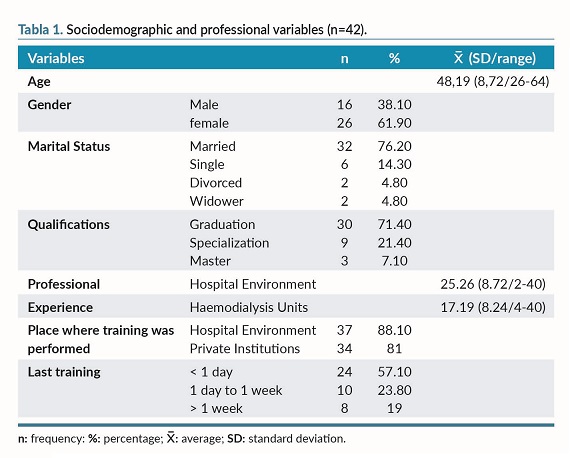
The dimensions of the perception of competence in which the participants of our study presented lower average scores in the pre-training moment were: “preparation for the HD session”, “connecting/establishing the extracorporeal circuit” and “evaluating and adjusting the effectiveness of the dialysis”. At the post-training moment, the dimensions that continue to present lower average scores are “monitoring during the HD session” and “evaluating and adjusting the effectiveness of dialysis” (table 2).
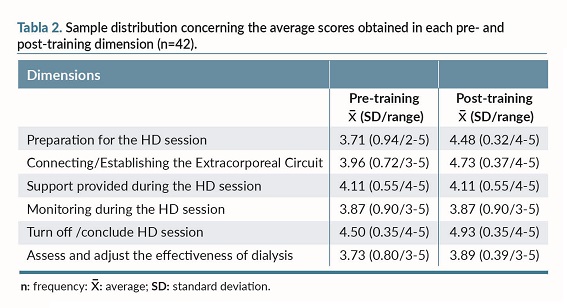
We proceeded to study the correlation between age and the various dimensions of the perception of competence (pre-training moment), calculating the Spearman Coefficient and the respective significance test. From the results obtained, we verified that there was a statistically significant correlation (p<0.05) between age and the dimensions “preparation of the person for the HD session” (rs=-0.16, p=0.04) and “turn on/establish the extracorporeal circuit” (rs=-0.06, p=0.05), with a negative correlation coefficient for both.
We recoded the variable qualifications into two categories: basic education (includes bachelor’s and teaching) and advanced education (includes specialization, post-graduation, master and PhD). Thus, we crossed these two new categories with the competence of the Dialysis Nurse, through the Man-Whitney U test. The data in table 3 reveal that there are no statistically significant differences (p>0.05). Thus, there is no evidence to affirm that educational qualifications influence the perception of competence of Dialysis Nurses.
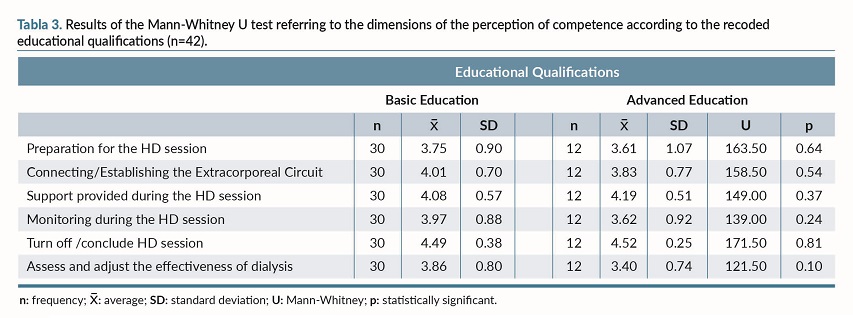
We proceeded to study the relation between the frequency of training actions, and the dimensions of the perception of competence. Through the results of the Man-Whitney U test, presented in table 4 we verified that there are statistically significant differences (p<0.05) between the frequency of training actions in the area of HD in the hospital service where nurses work and the competencies “connecting/establishing the extracorporeal circuit”, “support provided to the person during the HD session” and “evaluating and adjusting the dialysis efficiency”. This difference is more evident in the group of participants who report not having participated in training actions, namely in “connecting/establishing the extracorporeal circuit” (ẍ=4.68; SD=0.39), the support provided to the person during the session of HD” (ẍ=4.60; SD=0.52) and “evaluate and adjust the effectiveness of dialysis” (ẍ=4.50; SD=0.18). Thus, there is statistical evidence to affirm that at-tending training activities in a hospital environment influences the perception of competence.
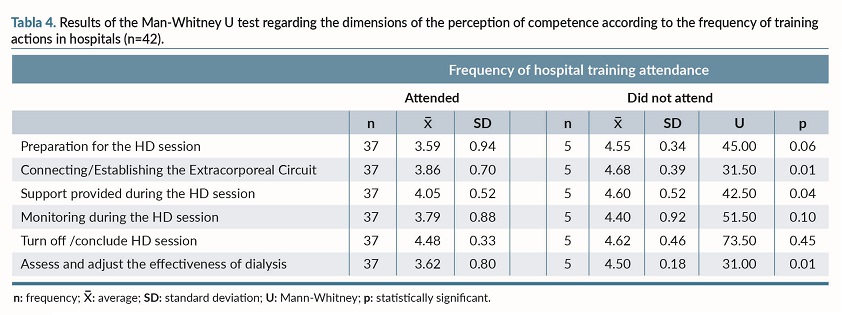
There is a significant influence of the duration of training actions on the perception of competence of the Dialysis Nurse. Therefore, we verified that there are statistically significant differences between groups (table 5), in the dimensions “support provided during the HD session” (H=1.05; p=0.02) and “turning off/completing the HD session” (H=1.15; p=0.01). Participants who performed training sessions lasting more than a week showed a greater perception of competence in the aforementioned dimensions. In the remaining dimensions, there were no statistically significant differences (p>0.05) between the groups.
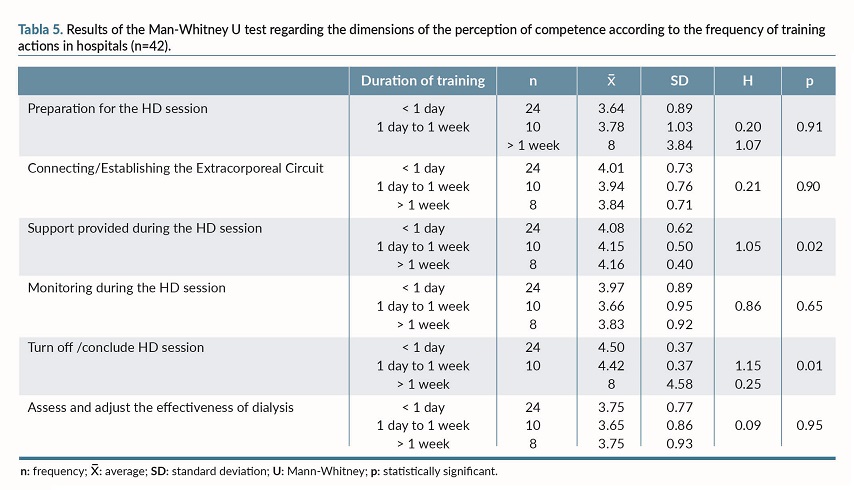
After the implementation of the training program (table 6), we found out that Nurses showed an improvement in the perception of competence in terms of the dimensions “preparation for the HD session”, “connecting/establishing the extracorporeal circuit” and “evaluate and adjust the effectiveness of dialysis” (p<0.05).

Regarding the remaining dimensions, the average values remained unchanged. The Wilcoxon test indicates that the differences found are statistically significant, in the referred dimensions, which allows us to partially accept the formulated hypothesis.
DISCUSSION
Regarding Dialysis Nurse’s Perception of Competence, we can observe the dimensions of the perception of competence in which the participants of our study presented higher scores in the post-training moment, corroborate with the Agencia de Calidad Sanitaria de Andalucía (ACSA)8 through which the two dialysis units of our research are certified. In our view, it is, therefore, the duty of Nurses to keep this standard up to date, using best practices, such as the use of identifiers, verbal confirmation of the person to be cared for and the use of an identification wristband.
The researcher Bakey9 mentioned that Nurses had a deficit in the practices that should be applied throughout the HD treatment, as they had a moderate level of practice in all interventions. Corroborating our study, the item “assessing weight and vital signs before starting treatment” also had a score above the average value.
Our participants had scores lower than the average values in the items “recognize signs and symptoms of infection by taking appropriate measures”, “connect CVC according to established standards” and “maintain asepsis when disconnecting the CVC”. The items may be subject to a more specific intervention in the online training program, following international guidelines on infection control policies.
A result similar to our study was found by Manandhar et al.10, who reported that Dialysis Nurses had a reasonable level of knowledge about aseptic technique, demonstrated knowledge to manage changes in blood pressure and cramps, but needed to improve the ability to deal with other complications.
Regarding Influence of age on the dialysis nurse’s perception of skills, most of the studies consulted regarding the competence of the HD Nurse do not ad-dress the relationship between age and the influence on competencies but highlight the importance of how many years of service they had, which also presupposes a more advanced age.
Our results point out that with increasing age, a lower perception of competence appears, which seems to corroborate the conclusions of previous studies, as mentioned by Lamb and Norton11 who refer to a lower competence in caring for the CKD person in HD in the group of older nurses.
Other researchers, such as Saleh et al.12, have shown that educational interventions and the training of Nurses have become effective in achieving a progressive improvement in knowledge and skills, especially in the age group between 30 and 40 years old.
Regarding influence of educational qualifications on the perception of Competencies of the Dialysis Nurse, the results obtained reveal that there is no evidence to affirm that academic qualifications influence the perception of competence of Dialysis Nurses.
Contrary to the literature, the results obtained by Manandhar et al.10 showed that bachelors and graduates were the ones who had the most knowledge about basic HD procedures, providing more frequent advice on them.
In the study by Saleh et al.12 statistically significant differences were found concerning the knowledge of Nurses, pre- and post-training and the Nurse’s degree of training.
Regarding influence of the frequency of training actions on the perception of dialysis nurses’ skills, we discovered that there are statistically significant differences between the frequency of training activities in the area of HD in the hospital service where nurses work and the skills “connect/establish the extracorporeal circuit”, “support provided to the person during the HD session” and “evaluate and adjust the effectiveness of dialysis”.
The results of our study were in line with the investigation by Lamb and Norton11. Regardless of previous experience in HD, Nurses from the HD unit attended a dialysis course at the hospital unit where they worked. A tutor was assigned to complete clinical HD skills. All participants reported improvements in their performance of their skills.
For the investigation by Kersten et al.13, the training program lasted four months. The training of a supervisor preceded the training program for Dialysis Nurses. The supervisors had a session with four hours of direct contact with the trainer. The supervisor’s training allowed to support the implementation of the intervention for the Dialysis Nurses.
Regarding effectiveness of the training program on hemodialysis techniques, we found out that the Nurses showed an improvement in the perception of competence in terms of the dimensions of “preparation for the HD session”, “connecting/establishing the extracorporeal circuit” and “evaluating and adjusting the effectiveness of dialysis”.
Our results seem to corroborate Saleh et al.12, who obtained an improvement in the post-training moment. Total knowledge was classified as very good and excellent in the same period and all Nurses continued to obtain the classification of very good and excel-lent in total knowledge in the follow-up period.
Kersten13, concluded that the systematically developed intervention for Dialysis Nurses offers a promising approach to health promotion in the dialysis setting.
On the other hand, Novita and Prasetyo14 in a recent study in which they assessed the relation between competence and person satisfaction, concluded that competence does not affect patient satisfaction. On the other hand, the Nurse’s competence contributed significantly to the quality of the service. They thus concluded that there is a significant influence between the competence of nurses and the quality of service.
Study limitations
We can consider the reduced sample size and the use of a non-probabilistic sampling technique, which creates the potential for selection bias, limiting the generalization of the study results. The sample being made up of Nurses from two different HD units, their proximity in terms of size and other characteristics of the participants, may constitute a limitation for the study.
The data collection instrument was built by the researchers, based on the skills of the Dialysis Nurse, and a pre-test was not carried out, nor its internal consistency was validated.
Despite the blended-learning training program being available, with access by the participants, the time elapsed between the beginning of the training and the collection of post-training data may have been insufficient for the consolidation of some contents.
The assessment of self-perception of competence, as there is no time to assess the competence of the Dialysis Nurse in practice, could also be considered a limitation.
The importance of the existence of properly structured and standardized training programs for Dialysis Nurses is an added value in the acquisition, consolidation and updating of knowledge.
In the “preparation for the HD session”, “connecting/establishing the extracorporeal circuit” and “evaluate and adjust the effectiveness of dialysis” dimensions, there was an increase in average values in the pre-training to post-training. Regarding the remaining dimensions, the average values remained unchanged. There was no decrease in any dimension.
It was defined as main goals: to characterize the competence profile of the Dialysis Nurse; to assess the influence of sociodemographic variables (age and educational qualifications) and the training (frequency and duration) on the competence profile of the Dialysis Nurse and to evaluate the effectiveness of a training program on HD techniques, in the perception of competence of the Dialysis Nurse.
We conclude that as age increases, the perception of competence decreases regarding the dimensions of “preparing the person for the HD session” and “turning on to establish the extracorporeal circuit”; we did not find statistically significant differences between educational qualifications and the perception of competence; the fact of attending training sessions in a hospital environment seems to positively influence the perception of competences in some dimensions; the frequency of training actions lasting more than a week seems to influence the perception of dialysis nurses skills; the effectiveness of the implementation of a training program on HD techniques was confirmed, in the perception of competence of the Dialysis Nurse.
Informed Consent Statement
Formal authorization was requested from the Board of Directors of the institution and a favourable opinion from the Ethics Committee for carrying out the study. All study participants received and signed informed consent.
Conflict of interest
The authors reported no declaration of interest.
BIBLIOGRAFÍA
1. Ordem dos Enfermeiros. Cuidados à Pessoa com Doença Renal Crónica Terminal em Hemodiálise. Guia Orientador de Boa Prática (2016), Vol. 1. Lisboa, Portugal.
2. Pássaro PG, D’ávila R. Intervenção Educacional de Enfermagem Para a Identificação Dos Eventos Adversos Em Hemodiá-lise. Revista Brasileira Enfermagem. 2018; 71(4):1597-604.
3. Gillespie BM, Harbeck EB, Falk-Brynhildsen, K.; Nilsson, U. Perceptions of Perioperative Nursing Competence: A Cross-Country Comparison. BMC Nursing. 2018;17(12).
4. Saraiva M, Richards M, Fortnum D. The profile of Nephrology Nursing: the fundamental roles of nephrology nurses caring for individuals with kidney disease, and their families (1ªed.). European Dialysis and Transplant Nurses Association/ Eu-ropean Renal Care Association (EDTNA/ERCA). 2018; Sweden:EDTNA/ERCA.
5. Thomas A, Silver SA, Rathe A, Robinson P, Wald R, Bell CM, et al. Feasibility of a Hemodialysis Safety Check-list for Nurses and Patients : A Quality Improvement Study. Clinical Kidney Journal. 2016;9(3):335–42.
6. Billings DM, Halstead JA. Teaching in nursing: A guide for faculty. Elsevier 2020.
7. Leidl DM, Ritchie L, Moslemi N. Blended learning in undergraduate nursing education. A scoping review. Nurse Educ Today. 2020;86:104318.
8. Direção-Geral da Saúde. Manual de Standards: Unidades de Gestão Clínica. 2017;Lisboa, Portugal: Departamento da Qualidade na Saúde.
9. Bakey S.J. Evaluation of Nurses’ Practices throughout Hemodialysis Treatment for Patients in Hemodialysis Unit at Bagh-dad Teaching Hospitals. Kufa Journal for Nursing Sciences. 2014;2(2):1–16.
10. Manandhar DN, Chhetri PK, Poudel P, Baidya SK. Knowledge and Practice of Hemodialysis amongst Dialysis Nurses. Journal of the Nepal Medical Association. 2017;56(207):346–51.
11. Lamb PC, Norton C. Nurses Experiences of Using Clinical Competencies a Qualitative Study. Nurse Education in Practice. 2018;31:177–81.
12. Saleh MS, Ali JS, Afifi WA. Nurses Compliance to Standards of Nursing Care for Hemodialysis Patients : Educational and Training Intervention. Journal of Nursing and Health Science. 2018;7(2):48-60.
13. Kersten M, Vincent-Höper S, Krampitz H, Nienhaus A. Development and Evaluation of a Training Program for Dialysis Nurses - An Intervention Study. Journal of Occupational Medicine and Toxicology. 2019;14(1):1-10.
14. Novita N, Prasetyo R. The Influence of Nurse Competence and Performance on Quality of Service and Patient Satisfaction. KnE Life Sciences. 2022;619-28.
Este artículo se distribuye bajo una Licencia Creative Commons Atribución–NoComercial 4.0 Internacional.
https://creativecommons.org/licenses/by-nc/4.0/
